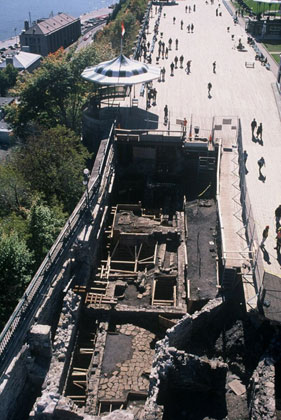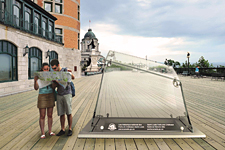Archeological discoveries
Saint-Louis Forts and Châteaux National Historic Site
Rewarding digs
The archeological research project currently underway at the Saint-Louis Forts and Châteaux National Historic Site began in June 2005. The final exploratory campaign was conducted in the summer of 2007.
The three digs confirmed the site's historical significance. Many architectural remains were excavated:
- Fortification elements associated with the four Saint-Louis forts
- Remains of the basements of the two Saint-Louis Châteaux
- Remains of several outbuildings constructed in the yard in front of the château and in the south yard.
 Part of the Dufferin Terrace, in front the Château Frontenac Hotel; archeological digs to the southern yard of the former Château Saint-Louis
Part of the Dufferin Terrace, in front the Château Frontenac Hotel; archeological digs to the southern yard of the former Château Saint-Louis© Parks Canada / P. Cloutier
Among other things, the digs revealed an impressive number of objects that bear witness to the daily lives of the governors and their immediate court, from the occupation by Samuel de Champlain and his men in 1620, until the Château Saint-Louis burned in 1834.
Major Discovery Under The Dufferin Terrace
Parks Canada Archaeologists Discover Champlain's Living Quarters Under The Dufferin Terrace
Information summarized from: News Release, August 24, 2007.
The base of the foundation's southwestern corner was buried in nearly six metres of earth, and concealed under the remains of later constructions. The discovery was part of the latest series of excavations under the Dufferin Terrace boardwalk.
This find provides archaeologists with information about the building Champlain died in, back in 1635. The discovery of what could be considered 'Champlain's last home' is highly significant. It adds to previous discoveries of many objects from the same period and of other vestiges that reveal the features of the early Saint-Louis Forts.
This discovery shows that the Dufferin Terrace is simply an expanded version of the terrace built by the founder of Quebec City. The governors who came after Champlain all maintained this terrace behind Château Saint-Louis. Therefore, the Dufferin Terrace could be seen as a legacy from the founder of Quebec City.
 Champlain's Dwelling
Champlain's Dwelling
© Jean-Sébastien Plante/Parks Canada
Click here to view a larger version of this photo (464 Kb).
(This image is larger than 450 pixels)
A Look Under Dufferin Terrace
Parks Canada Introduces the Archaeoscope

A Look Under Dufferin Terrace
In 2012, Parks Canada installed three archaeoscopes on Dufferin Terrace. These five-foot-tall glass prisms will allow visitors to view the Saint-Louis Forts and Châteaux National Historic Site's archaeological remains at all times. Installation should be completed within a month.
The archaeoscopes are a new concept that will now allow thousands of visitors to view the foundations of the Saint-Louis Forts and Châteaux under a new light. The rich history of this site where a number of important decisions were made for the future of our country is now rightfully presented.
To implement this state-of-the-art approach to sharing our heritage, Parks Canada carefully preserved the magic of the site, to ensure that visitors would be proud of seeing these cutting-edge devices appear on the Terrace.
The Terrace and the remains of the Saint-Louis Forts and Châteaux are landmark attractions for visitors to the Old City and local residents alike. They are among the busiest parts of the Old City tourism infrastructure, the terrace registering over 825,000 visits in 2011.
Saint-Louis Forts and Châteaux National Historic Site is located under the Dufferin Terrace and harbours the vestiges of the residences of those French and British governors who held office between 1620 and 1834. The Durham Terrace, renamed the Dufferin Terrace in 1879, was built on the ruins of the last château after its destruction by fire. The Saint-Louis Forts and Châteaux, a seat of power, were recognized by the Historic Sites and Monuments Board of Canada in 2001 and are part of the Historic District of Old Québec, a UNESCO World Heritage Site.
- Date modified :